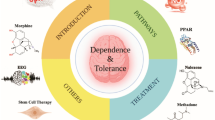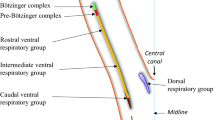Abstract
Our previous study found that activation of adenosine A1 receptor (A1R) induced phosphorylation of delta opioid receptor (DOR) and desensitization of its downstream signaling molecules, cAMP and Akt. To further investigate the effect of A1R agonist on DOR signaling and the underlying mechanism, we examined the effect of A1R activation upon binding of its agonist N6-cyclohexyl-adenosine (CHA) on DOR-mediated Raf-1/MEK/ERK activation, and found that prolonged CHA exposure resulted in downregulation of DOR-mediated Raf-1/MEK/ERK signaling pathway. CHA-treatment time dependently attenuated Raf-1-Ser338 phosphorylation induced by [D-Pen2,5] enkephalin (DPDPE), a specific agonist of DOR, and further caused downregulation of the Raf-1/MEK/ERK signaling pathway activated by DOR agonist. Moreover, CHA exposure time-dependently induced the phosphorylation of Raf-1-Ser289/296/301, the inhibitory phosphorylation sites that were regulated by negative feedback, thereby inhibiting activation of the MEK/ERK pathway, and this effect could be blocked by MEK inhibitor U0126. Finally, we proved that the heterologous desensitization of the Raf-1/MEK/ERK cascade was essential in the regulation of anti-nociceptive effect of DOR agonists by confirming that such effect was inhibited by pretreatment of CHA. Therefore, we conclude that the activation of A1R inhibits DOR-mediated MAPK signaling pathway via heterologous desensitization of the Raf-1/MEK/ERK cascade, which is a result of ERK-mediated Raf-1-Ser289/296/301 phosphorylation mediated by activation of A1R.







Similar content being viewed by others
Data Availability
Data sharing not applicable to this article as no datasets were generated or analysed.
during the current study.
References
Araldi D, Ferrari LF, Levine JD (2016) Adenosine-A1 receptor agonist induced hyperalgesic priming type II. Pain 157:698–709
De Lander GE, Keil GJ 2nd (1994) Antinociception induced by intrathecal coadministration of selective adenosine receptor and selective opioid receptor agonists in mice. J Pharmacol Exp Ther 268:943–951
Peart JN, Gross GJ (2003) Adenosine and opioid receptor-mediated cardioprotection in the rat: evidence for cross-talk between receptors. Am J Physiol Heart Circ Physiol 285:H81–89
Tosh DK, Ciancetta A, Mannes P, Warnick E, Janowsky A, Eshleman AJ, Gizewski E, Brust TF, Bohn LM, Auchampach JA, Gao ZG, Jacobson KA (2018) Repurposing of a Nucleoside Scaffold from Adenosine receptor agonists to opioid receptor antagonists. ACS Omega 3:12658–12678
Cheng Y, Tao YM, Sun JF, Wang YH, Xu XJ, Chen J, Chi ZQ, Liu JG (2010) Adenosine A(1) receptor agonist N(6)-cyclohexyl-adenosine induced phosphorylation of delta opioid receptor and desensitization of its signaling. Acta Pharmacol Sin 31:784–790
Shaw S, Uniyal A, Gadepalli A, Tiwari V, Belinskaia DA, Shestakova NN, Venugopala KN, Deb PK, Tiwari V (2020) Adenosine receptor signalling: probing the potential pathways for the ministration of neuropathic pain. Eur J Pharmacol 889:173619
Diao XT, Yao L, Ma JJ, Zhang TY, Bai HH, Suo ZW, Yang X, Hu XD (2020) Analgesic action of adenosine A1 receptor involves the dephosphorylation of glycine receptor alpha1(ins) subunit in spinal dorsal horn of mice. Neuropharmacology 176:108219
Chang JK, Cornwell WD, Rogers TJ (2021) The mu-opioid receptor induces miR-21 expression and is ERK/PKCmu-dependent. J Neuroimmunol 356:577585
Little AS, Smith PD, Cook SJ (2013) Mechanisms of acquired resistance to ERK1/2 pathway inhibitors. Oncogene 32:1207–1215
Wellbrock C, Karasarides M, Marais R (2004) The RAF proteins take centre stage. Nat Rev Mol Cell Biol 5:875–885
Jaffre F, Miller CL, Schanzer A, Evans T, Roberts AE, Hahn A, Kontaridis MI (2019) Inducible pluripotent stem cell-derived cardiomyocytes reveal aberrant Extracellular regulated kinase 5 and mitogen-activated protein kinase kinase 1/2 signaling concomitantly promote hypertrophic cardiomyopathy in RAF1-Associated Noonan Syndrome. Circulation 140:207–224
Takahashi M, Li Y, Dillon TJ, Kariya Y, Stork PJS (2017) Phosphorylation of the C-Raf N region promotes Raf Dimerization.Mol Cell Biol37
Ory S, Zhou M, Conrads TP, Veenstra TD, Morrison DK (2003) Protein phosphatase 2A positively regulates ras signaling by dephosphorylating KSR1 and Raf-1 on critical 14-3-3 binding sites. Curr Biol 13:1356–1364
Dumaz N, Marais R (2003) Protein kinase A blocks Raf-1 activity by stimulating 14-3-3 binding and blocking Raf-1 interaction with ras. J Biol Chem 278:29819–29823
Han S, Meier KE (2009) Integrated modulation of phorbol ester-induced raf activation in EL4 lymphoma cells. Cell Signal 21:793–800
Balan V, Leicht DT, Zhu J, Balan K, Kaplun A, Singh-Gupta V, Qin J, Ruan H, Comb MJ, Tzivion G (2006) Identification of novel in vivo Raf-1 phosphorylation sites mediating positive feedback Raf-1 regulation by extracellular signal-regulated kinase. Mol Biol Cell 17:1141–1153
Dougherty MK, Muller J, Ritt DA, Zhou M, Zhou XZ, Copeland TD, Conrads TP, Veenstra TD, Lu KP, Morrison DK (2005) Regulation of Raf-1 by direct feedback phosphorylation. Mol Cell 17:215–224
Yang PP, Yeh GC, Yeh TK, Xi J, Loh HH, Law PY, Tao PL (2016) Activation of delta-opioid receptor contributes to the antinociceptive effect of oxycodone in mice. Pharmacol Res 111:867–876
Favata MF, Horiuchi KY, Manos EJ, Daulerio AJ, Stradley DA, Feeser WS, Van Dyk DE, Pitts WJ, Earl RA, Hobbs F, Copeland RA, Magolda RL, Scherle PA, Trzaskos JM (1998) Identification of a novel inhibitor of mitogen-activated protein kinase kinase. J Biol Chem 273:18623–18632
Cahill CM, Holdridge SV, Liu SS, Xue L, Magnussen C, Ong E, Grenier P, Sutherland A, Olmstead MC (2022) Delta opioid receptor activation modulates affective pain and modality-specific pain hypersensitivity associated with chronic neuropathic pain. J Neurosci Res 100:129–148
Zhang X, Kim KM (2017) Multifactorial regulation of G protein-coupled receptor endocytosis. Biomol Ther (Seoul) 25:26–43
Xu C, Hong MH, Zhang LS, Hou YY, Wang YH, Wang FF, Chen YJ, Xu XJ, Chen J, Xie X, Ma L, Chi ZQ, Liu JG (2010) Serine 363 of the {delta}-opioid receptor is crucial for adopting distinct pathways to activate ERK1/2 in response to stimulation with different ligands. J Cell Sci 123:4259–4270
Tran NH, Wu X, Frost JA (2005) B-Raf and Raf-1 are regulated by distinct autoregulatory mechanisms. J Biol Chem 280:16244–16253
Xu C, Zhang Y, Zheng H, Loh HH, Law PY (2014) Morphine modulates mouse hippocampal progenitor cell lineages by upregulating miR-181a level. Stem Cells 32:2961–2972
Xu C, Zheng H, Loh HH, Law PY (2015) Morphine promotes astrocyte-preferential differentiation of mouse hippocampal progenitor cells via PKCepsilon-Dependent ERK activation and TRBP phosphorylation. Stem Cells 33:2762–2772
Navratilova E, Waite S, Stropova D, Eaton MC, Alves ID, Hruby VJ, Roeske WR, Yamamura HI, Varga EV (2007) Quantitative evaluation of human delta opioid receptor desensitization using the operational model of drug action. Mol Pharmacol 71:1416–1426
Leduc-Pessah H, Xu C, Fan CY, Dalgarno R, Kohro Y, Sparanese S, Burke NN, Jacobson KA, Altier C, Salvemini D, Trang T (2021) Spinal A3 adenosine receptor activation acutely restores morphine antinociception in opioid tolerant male rats. J Neurosci Res
Okumura T, Nozu T, Ishioh M, Igarashi S, Kumei S, Ohhira M (2020) Adenosine A1 receptor agonist induces visceral antinociception via 5-HT1A, 5-HT2A, dopamine D1 or cannabinoid CB1 receptors, and the opioid system in the central nervous system. Physiol Behav 220:112881
Ramos-Zepeda GA, Herrero-Zorita C, Herrero JF (2014) Interaction of the adenosine A1 receptor agonist N6-cyclopentyladenosine and kappa-opioid receptors in rat spinal cord nociceptive reflexes. Behav Pharmacol 25:741–749
Quirion B, Bergeron F, Blais V, Gendron L (2020) The Delta-Opioid receptor; a target for the treatment of Pain. Front Mol Neurosci 13:52
Berthiaume S, Abdallah K, Blais V, Gendron L (2020) Alleviating pain with delta opioid receptor agonists: evidence from experimental models. J Neural Transm (Vienna) 127:661–672
Kibaly C, Xu C, Cahill CM, Evans CJ, Law PY (2019) Non-nociceptive roles of opioids in the CNS: opioids’ effects on neurogenesis, learning, memory and affect. Nat Rev Neurosci 20:5–18
Persson AI, Thorlin T, Bull C, Zarnegar P, Ekman R, Terenius L, Eriksson PS (2003) Mu- and delta-opioid receptor antagonists decrease proliferation and increase neurogenesis in cultures of rat adult hippocampal progenitors. Eur J Neurosci 17:1159–1172
Lutz PE, Kieffer BL (2013) Opioid receptors: distinct roles in mood disorders. Trends Neurosci 36:195–206
Torregrossa MM, Isgor C, Folk JE, Rice KC, Watson SJ, Woods JH (2004) The delta-opioid receptor agonist (+)BW373U86 regulates BDNF mRNA expression in rats. Neuropsychopharmacology 29:649–659
Liu YJ, Chen J, Li X, Zhou X, Hu YM, Chu SF, Peng Y, Chen NH (2019) Research progress on adenosine in central nervous system diseases. CNS Neurosci Ther 25:899–910
Caruana DA, Dudek SM (2020) Adenosine A1 receptor-mediated synaptic depression in the developing hippocampal area CA2. Front Synaptic Neurosci 12:21
Serchov T, Schwarz I, Theiss A, Sun L, Holz A, Dobrossy MD, Schwarz MK, Normann C, Biber K, van Calker D (2020) Enhanced adenosine A1 receptor and Homer1a expression in hippocampus modulates the resilience to stress-induced depression-like behavior. Neuropharmacology 162:107834
Li Y, Li L, Wu J, Zhu Z, Feng X, Qin L, Zhu Y, Sun L, Liu Y, Qiu Z, Duan S, Yu YQ (2020) Activation of astrocytes in hippocampus decreases fear memory through adenosine A1 receptors. Elife 9
Acknowledgements
This work was supported by Zhejiang Provincial Natural Science Foundation of China under Grant. No. LY22H270004, by Zhejiang Chinese Medical University under Grant No. 2020ZG53, and by National Natural Science Foundation of China under Grant No. 82030112. We appreciate the technical support from the Public Platform of Medical Research Center, Academy of Chinese Medical Science, Zhejiang Chinese Medical University.
Author information
Authors and Affiliations
Corresponding authors
Ethics declarations
Conflict of interest
The authors have no conflicts of interest to declare.
Additional information
Publisher’s Note
Springer Nature remains neutral with regard to jurisdictional claims in published maps and institutional affiliations.
Chi Xu, Yun Cheng and Manman Han these authors have contributed equally to this work.
Rights and permissions
Springer Nature or its licensor (e.g. a society or other partner) holds exclusive rights to this article under a publishing agreement with the author(s) or other rightsholder(s); author self-archiving of the accepted manuscript version of this article is solely governed by the terms of such publishing agreement and applicable law.
About this article
Cite this article
Xu, C., Cheng, Y., Han, M. et al. The Agonist of Adenosine A1 Receptor Induced Desensitization of delta Opioid receptor-mediated Raf-1/MEK/ERK Signaling by Feedback Phosphorylation of Raf-1-Ser289/296/301. Neurochem Res 48, 1531–1542 (2023). https://doi.org/10.1007/s11064-022-03843-2
Received:
Revised:
Accepted:
Published:
Issue Date:
DOI: https://doi.org/10.1007/s11064-022-03843-2




